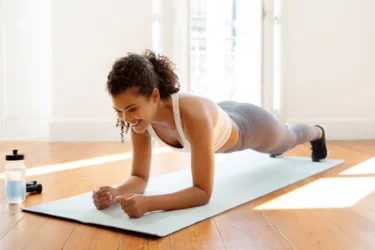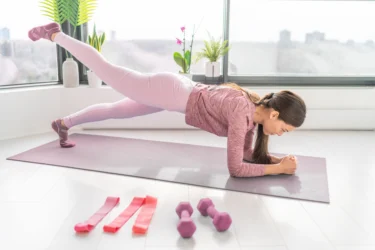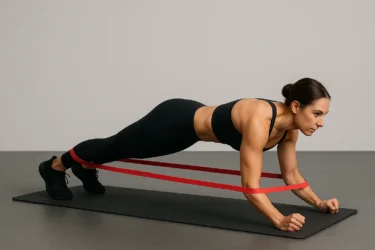Benefits of Doing the Plank Exercise Every Day
By Dr. Himani Bisht +2 more

Get,

to manage your symptom
Get your,


4 Cr+ families
benefitted

OTP sent to 9988776655



You’ve successfully subscribed to receive
doctor-approved tips on
Whatsapp

Get ready to feel your best.

Hi There,
Download the PharmEasy App now!!


Register to Avail the Offer
Send OTPBy continuing, you agree with our Privacy Policy and Terms and Conditions

Hi There,
Sign up on PharmEasy now!!
Trusted by 4 crore+ families

OTP sent to 9988776655



You have unlocked 25% off on medicines




Code: NU25
By Dr. Himani Bisht +2 more
Table of Contents
There are different approaches to stay healthy.
Engaging in a regular physical activity routine can contribute significantly to overall well-being. It may also play a supportive role in managing certain health conditions. For example, exercises for diabetes may help manage sugar levels as part of a broader lifestyle management plan, under medical guidance1.

Among various forms of exercise, one simple yet effective option is the plank. This bodyweight exercise focuses on strengthening the core muscles, which can contribute to better posture, stability, and balance.
The plank exercise is widely regarded as one of the most effective movements for strengthening the core and abdominal muscles2,3. It engages several muscle groups simultaneously, including the hips, lower back, and abdominal region, contributing to improved posture, balance, and overall stability.
The number of calories burned during a plank exercise can vary depending on factors such as body weight, duration, and individual metabolism.
For example, a person weighing approximately 65 kilograms may burn around 3 calories per minute while holding a plank position4. You may observe the following benefits from plank exercising
In addition to supporting muscle growth and endurance, the plank exercise may also contribute to improved body balance, posture, and coordination5. Enhanced balance can help promote more efficient movement and may reduce the likelihood of placing undue strain on individual muscle groups during physical activity. As a result, incorporating planks into a well-rounded exercise programme can support safer and more stable performance, particularly during dynamic or high-impact workouts.
The core of your body consists of the spine, pelvis, and trunk, forming the foundation for stability and movement. Developing core strength can support better posture and enhance performance in a range of physical activities. The plank exercise is particularly effective in targeting four key muscle groups that make up the core: the transversus abdominis, which helps stabilise the spine; the rectus abdominis, important for spinal flexion; the oblique muscles, which aid in rotation and lateral movement; and the gluteal muscles (glutes), essential for hip support and lower body strength. Regularly practising the plank may assist in strengthening these muscles, thereby contributing to improved balance, coordination, and physical resilience during exercise2.
Practicing the plank pose daily can help to stretch your core muscle groups mentioned earlier. This has a lot of benefits, especially for those who engage in yoga.
Since the plank pose mainly works your core abdominal muscles, it is a great exercise to get rid of stubborn belly fat. Holding a plank for a few minutes each day can alone help to trump down belly fat and provide an appealing shape to your body. Regular practice of the plank exercise may also support improved body flexibility, particularly when performed as part of a balanced fitness routine. While the plank is primarily a strength-building movement, it engages multiple muscle groups, including the shoulders, hamstrings, calves, and the arches of the feet, which can help maintain or gently increase range of motion over time. Certain plank variations, such as side planks or forearm planks with leg lifts, further activate and stretch surrounding muscles, promoting greater mobility and control. Improved flexibility can contribute to more fluid movement, reduced muscular tension, and enhanced overall functional fitness6.
The plank posture helps to perfectly align the vertebrae (small bones) in the backbone. This can help reduce back pain and even delay the onset of or prevent back pain in old age. Moreover, since this pose strengthens your abdominal muscles, it will help support the weight of your body when walking upright. This will further help to prevent back pain7.
The plank pose strengthens the abdominal muscles and, through improved core stability, may also support muscle development in other areas of the body. Increased muscle mass is generally linked to higher energy expenditure, which can aid natural metabolic function. When practised regularly, the plank may contribute to better energy balance and appetite regulation8.
The plank exercise is a type of isometric exercise. Isometric exercises are mainly performed to improve strength. These exercises do not need movement and can be done in one place. As there is no movement involved, it will provide strength in a certain position only. Therefore, isometric exercises like plank can be done during injuries. Athletes who want to build strength are advised to practice planks9.
Dr. Siddharth Gupta, B.A.M.S, M.D (Ayu)
There are several variations of this comprehensive exercise, each offering distinct benefits to different parts of the body.

The front plank is a simple form of this exercise and may promote strengthening of the upper as well as lower body. The side plank, on the other hand, helps to strengthen the oblique abdominal muscles. This can be beneficial in reducing belly fat. However, a reverse plank is a slightly uncommon variation of this popular exercise pose. It is, as the name suggests, a reverse of the original position and helps to strengthen your hip muscles (glutes) and hamstrings (back thigh muscle), back & shoulder/

The 2-minute plank test involves holding the traditional plank position for a full two minutes. While this may appear manageable for those who exercise regularly, it can be quite demanding for beginners. This variation serves as an effective way to assess core muscle endurance and overall stability.

These variations are considered more advanced forms of the plank, as they place greater demand on the core muscles, helping to further enhance strength and stability. To perform them, begin in the standard plank position and lift either one arm or one leg, alternating between sides to increase intensity. For added challenge and variety, these movements can also be combined with side planks to engage a broader range of muscle groups.

This is one of the most challenging and effective plank variations, often recommended for individuals with an established fitness routine. However, with consistent and careful practice, it can also be performed at home. To do this exercise, begin in a side plank position and draw the upper leg towards the body in a movement similar to a crunch. This variation engages the core abdominal muscles while also helping to strengthen the muscles around the hip joints.

This variation can also be performed using resistance bands and is considered an advanced form of the plank exercise. It is suitable for individuals who have built confidence with the basic variations. To practise this, position yourself in the standard plank and secure a resistance band around your wrists and ankles. While holding the posture, gently push outwards against the resistance. This added tension increases the challenge, helping to further engage and strengthen the muscles and supporting joints.
The plank exercise is primarily aimed at developing stamina, muscular endurance, and core strength. It targets key muscle groups, including the erector spinae (ES), external oblique (EO), and rectus abdominis (RA), all of which play a vital role in maintaining posture and supporting spinal alignment.
Dr. Rajeev Singh, BAMS
Level: Beginner
Type: Forearm Plank (Low Plank)
The Forearm Plank, also known as the Low Plank, is a fundamental core-strengthening exercise that focuses on building endurance, stability, and muscle control. It involves maintaining a straight, aligned position while resting the body’s weight on the forearms and toes.
NOTE: Beginners may start with shorter durations and build up gradually. Proper form is essential to prevent strain, especially on the lower back.
Do not do planks in the following cases:
NOTE: If you experience any of the discomforts or pains mentioned above, it is advisable to consult a medical professional for further guidance before continuing with this exercise.
Ultimately, take time to enjoy the entire process. With consistent effort and patience, you will gradually become stronger and more resilient. As your endurance improves, continue to challenge yourself by adding a few extra seconds to your plank hold — and take pride in your progress.
The plank exercise can contribute to overall calorie expenditure when practised regularly and as part of a balanced fitness routine. For best results, it should be complemented by a healthy and nutritious diet. Incorporating foods such as fresh fruits, whole grains, yoghurt, bananas, avocados, green tea, and lean proteins like fish may support overall well-being and energy levels.
When performing the plank, it is important to maintain proper form. Try to hold the position for 10 seconds at a time between movements, gradually building up to a total of 60 seconds per session, based on your comfort and ability. Consistency and correct technique are key to making steady progress.
Plank exercises involve multiple muscle groups across the body, particularly the core, arms, and shoulders. As a full-body movement, planks may also support improved posture and help reduce strain on the lower back when performed correctly. For this reason, it is essential to maintain proper form during the exercise. Poor technique can lead to unnecessary stress on joints and muscles, potentially resulting in discomfort or injury to areas such as the wrists, shoulders, neck, or lower back.
In both high planks (full arm extended) and low plank (only forearms) exercises, a common mistake is allowing the hips to drop below the natural alignment of the body. This misalignment reduces engagement of the core muscles—one of the primary targets of the exercise—and can place undue strain on the lower back and shoulders. To correct this, ensure your hips remain level and in line with your shoulders throughout the duration of the plank. Maintaining a straight, stable posture is key to performing the exercise safely and effectively.
When performing side planks, placing your supporting arm too far from your body can lead to unnecessary strain on the shoulder, wrist, and neck. To avoid this, your shoulder should be positioned directly above the supporting wrist or elbow, depending on the variation. For correct alignment, ensure your support hand (or forearm) is directly beneath the shoulder, your upper arm is extended vertically above you, and your legs are stretched out in a straight line. This forms a ‘T’ shape with your body and helps maintain balance, stability, and proper muscle engagement.
A common mistake during plank exercises is angling the palms inward towards the centre of the body. This positioning can make it more difficult to stabilise the shoulders and may lead to the chest collapsing towards the floor, increasing the risk of strain. To maintain proper form and reduce the likelihood of injury, ensure your hands are placed parallel to each other, with fingers slightly turned outwards. Keep the elbows straight but not locked, allowing the shoulders to remain engaged and the chest lifted in a stable position.
Also Read: 7 Best Exercises to Lose Weight at Home
Given the numerous benefits associated with this seemingly simple exercise, it is no surprise that the plank posture has gained popularity among fitness enthusiasts. Many fitness professionals have introduced their own innovative variations, offering unique ways to challenge and engage the body. Even if these advanced forms are not accessible at first, the variations and tips outlined here provide effective alternatives that can yield comparable results. As a full-body exercise that complements a wide range of workout routines, the plank is a valuable addition to any fitness programme and well worth incorporating into your regular practice.
Also Read: Benefits of Sarvangasana (Shoulder Stand) and How to Do It By Dr. Himani Bisht
Yes, a 3-minute plank workout is achievable, particularly for those following an advanced fitness routine. For beginners, holding a plank for one minute is generally sufficient and effective. Reaching the three-minute mark typically indicates a higher level of core strength and endurance. However, if you are unable to maintain proper form for up to 120 seconds during an advanced routine, it may suggest the need to further develop your strength or reassess your technique. Ensuring correct posture is essential for both safety and effectiveness.
Incorporating planks into your daily routine can offer several potential benefits, particularly when performed with proper form and as part of a balanced fitness programme. Some of the key advantages may include:
– Improves body flexibility
– Strengthens the arms, legs, and spinal muscles.
– Improves running speed and efficiency
The recommended duration for planking varies depending on individual fitness levels and any underlying medical conditions. For most people, holding a plank for up to two minutes is sufficient to build core strength and endurance. Beginners may start with a 30-second hold and gradually increase the duration as their strength improves. It is always advisable to listen to your body and consult a healthcare or fitness professional if you have any concerns or pre-existing health conditions.
It is common to experience trembling or shaking while holding a plank, particularly when you are new to the exercise. This occurs because the movement requires your muscles to support your entire body weight, placing significant demand on the core, shoulders, arms, and legs. The shaking is a sign that your muscles are being challenged and are working to stabilise your body. As your strength and endurance improve over time, this response typically becomes less pronounced.
No, while plank exercises are highly effective for strengthening the core, spine, and shoulders, as well as supporting posture and flexibility, they alone are not sufficient for overall physical conditioning. Planks can contribute to maintaining fitness and may assist in reducing body fat as part of a broader routine. However, for comprehensive health and visible physical transformation, it is recommended to combine planks with cardiovascular activities such as jogging, cycling, swimming, or walking, along with strength training and a balanced, nutritious diet.
Disclaimer: The information provided here is for educational/awareness purposes only and is not intended to be a substitute for medical treatment by a healthcare professional and should not be relied upon to diagnose or treat any medical condition. The reader should consult a registered medical practitioner to determine the appropriateness of the information and before consuming any medication. PharmEasy does not provide any guarantee or warranty (express or implied) regarding the accuracy, adequacy, completeness, legality, reliability or usefulness of the information; and disclaims any liability arising thereof.
Comments

Leave your comment...
You may also like
Comments